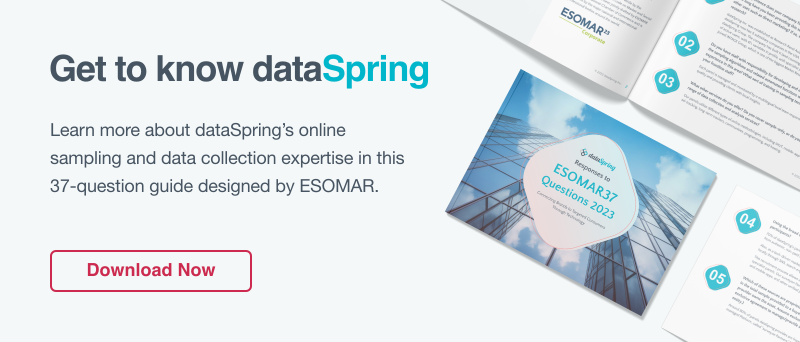
Use this expert checklist to maximize value, save time and minimize issues with your study.
As the business planning cycle accelerates, more and more pressure is put on market research teams to deliver deeper insights more quickly and on a tighter budget at every stage of the process. Studies that just a few decades ago took months and a six-figure budget to complete are now conducted in weeks at significantly less cost. While this efficiency has been a great benefit for researchers and consultants, the quest for speed can lead to issues that contribute to missed deadlines and compromised data quality.

Tomohiro Hosono is Global Technical Director at dataSpring and provides six key items to consider incorporating into your research process to help ensure success.
Study Success Checklist
-
Be Prepared
Incomplete or unclear specs are one of the main drivers of issues during a study. -
Invite Feedback
Don’t hesitate to ask for input and suggestions from your trusted research partners. -
Set Clear Expectations
Communicate your specific needs with regard to timing, deliverables, and communication preferences -
Know the Team
Confirm upfront that the right resources are assigned based on your study specifics. -
Pilot Testing
Consider for studies that feature unusually complex questionnaires or low incidents samples. -
Experience and References
A reputable firm should be willing to provide you with the names of clients whom they work with regularly.
Be specific with what you need, down to the smallest detail.
Here are the six ways to get the most from your full-service research supplier.
1. Be Prepared
Okay, this is obvious, but it still bears repeating. Incomplete or unclear specs are one of the main drivers of issues during the study. Tomo explains, “Even if the basic studies specs – sample size, target criteria, questionnaire length – are not finalized, it is important to kick off the project with a set of study assumptions that everyone can work from.” Why are these elements so important? Sample size, target incidence, and questionnaire length/complexity drive study cost and timing. This is especially important when evaluating proposals from multiple suppliers. It is imperative to make sure bids and timing are based on the same study specs.

Also consider any potential non-standard needs, such as additional open-ended questions, special or unique question types that may require custom scripting, or embedding or linking to images or video. “The more we know upfront, the better we can plan and allocate our resources to ensure the job gets done on time and on budget," continues Mr. Hosono.
2. Invite Feedback
Experienced suppliers have a wealth of information based on conducting past studies. So, while it is important to articulate specifics, don’t hesitate to ask for input and suggestions from your trusted research partners on feasibility and approach. While online is the dominant data collection method today, some study types or target samples may not be suited to this method. Use your research partners’ experience to enhance your own knowledge and field a more successful study.

The same goes for studies that demand a quick turnaround. “There will always be a supplier who will say ‘we can do it,’ no matter what the spec, relying only on hope that everything goes perfectly,” says Tomo. This no-margin for error approach can lead to issues further along. “We try and provide an honest and realistic evaluation of feasibility. As much as we want to please clients upfront, we know that to become a long-term partner requires delivering on what we promise.” Better to push back and set realistic applications with stakeholders early in the process than to fail to deliver later.
3. Set Clear Expectations
It is essential to communicate your specific needs with regard to timing, deliverables, and even communication preferences. This is especially true with quick turnaround projects (and what isn’t considered a quick turnaround project these days?), so be specific with your timing needs, even down to the time of day you need specific deliverables. Avoid ambiguous timing terms like 'late next week' or 'by mid-day' that can be open to interpretation. Also, make sure your research partner repeats back and confirms these needs.

The same goes for deliverables. For example, the term 'Topline' can include a range of different deliverables, from simple tables to charts, to graphs with written summaries. “We encourage our clients to provide examples so we know we are delivering as expected,” Tomo adds. Be as specific as possible with what you need.
An often-overlooked area of expectations setting is in communication preferences. Be clear about how and when you want to be informed of study progress. “Some clients like daily updates, while some prefer only to know when key milestones are completed,” says Tomo. Also, be clear about the communication channel and be specific. While email has become the default channel, let your partner know if you prefer a text or phone call when the circumstances dictate.
4. Know the Team
Most reputable market research firms have in-house expertise in a number of areas. It is important, however, to ensure that those experts will, in fact, be working on your project. Confirm upfront that the right resources are assigned based on your study’s specific method (online, mobile, etc.), regional focus (Asia, EMEA), study type (concept test, tracking study) and/or translation needs.

5. Pilot Testing
For studies that feature unusually complex questionnaires, or low incidents samples, Tomo recommends conducting a pilot study. “We always perform extensive QA on our projects, but a pilot test provides an added level of confidence that the questionnaire is performing correctly.” A pilot also confirms respondents can successfully complete the survey and, if necessary, pinpoint potential issues like high dropout rates. “In multi-country studies, we often need to slightly adapt our screener questions based on cultural or economic differences between countries or regions.” A pilot study helps ensure the right respondents are getting through.

6. Experience and References
Nothing beats an experienced team to help a study go smoothly. So don’t be shy about inquiring about specific expertise. The same goes for references. A reputable firm should be willing to provide you with the names of clients whom they work with regularly. And while these references will likely represent the research firm’s most satisfied clients, almost all clients will be forthcoming with the firm’s specific strengths and weaknesses.

Tomo believes all the items that contribute to a successful study really come down to a single, simple idea: Be specific with what you need, down to the smallest detail. “When we have clear and precise specifications - sample size, target criteria, questionnaire length, timing, and deliverable requirements – we are incredibly confident in our ability to deliver 100% satisfaction.” That being said, it is also important to plan for the unexpected. While most research suppliers can ably handle a well-planned study, flexibility is also important. Be sure to find out how your research partner is structured and equipped to handle last-minute changes or address issues mid-study. “In our case, we have a centralized operations hub that runs 24/7. It gives us the ability to immediately address issues and reassign resources, as needed.”


 Download Panel Book
Download Panel Book


